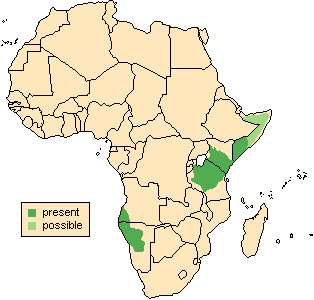![]() Return
to Artiodactyla
Return
to Artiodactyla
Classification
|
 Madoqua kirkii
Madoqua kirkii
Kirk's dik-dik
![]()
Taxonomy
 |
 |
 |
Click on the pictures above for a larger view of the
photographs
|
||
General Characteristics
Body Length: 55-77 cm / 1.8-2.5 ft.
Shoulder Height: 35-45 cm / 14-18 in.
Tail Length: 4-6 cm / 1.6-2.4 in.
Weight: 2.7-6.5 kg / 5.9-14.3 lb.The coat is an overall grizzled grey-brown to reddish brown, while the head and legs are tawny in colour. The undersides, including the insides of the legs and bottom of the chin, are white. Around the large eye is a bright ring of white hair. One of the most humorous features of this small antelope is the elongated, prehensile nose. Only males bear the corrugated horns, which may grow up to 11.4 cm / 4.5 inches long. These may be slightly hidden by the erectile forelock.
Ontogeny and Reproduction
Gestation Period: 5-6 months.
Young per Birth: 1
Weaning: After 3-4 months.
Sexual Maturity: Females at 6-8 months, males at 8-9 months.
Life span: Up to 10 yearsBirthing peaks occur from November-December and April-May. After birth, kids lie concealed away from their mother for 2-3 weeks. Although they grow up with their parents, the young are ejected from the home territory at 7-8 months. Females may bear up to two young per year.
Ecology and Behavior
Kirk's dik-dik is primarily active in the morning and late afternoon, although some activity may continue throughout the night. Mated pairs defend a territory 12.5-75 acres in size, and if no unexpected unfavourable conditions arise, this pair may occupy the same territory for life. Definite trails run through the thick cover, which are used with some regularity. Along the boundaries of the territory, and other places important to the animals, they deposit dung heaps approximately 30 cm / 12 inches in diameter. Both sexes mark the range of their territory with secretions from their preorbital glands, although this is done much more frequently by males. Despite joint marking, only the male defends the family range, chasing away any intruders of the same species, including other females. When startled dik-diks make quick zigzag leaps, dashing for cover while making a call that resembles "zik-zik" or "dik-dik" (see opening notes). Population density in the Serengeti is about 24 animals per square kilometer.Family group: Permanent breeding pairs.
Diet: Leaves of bushes and shrubs, buds, shoots, fruits, grasses. Needs much salt and little water.
Main Predators: Lion, leopard, cheetah, caracal, hyena, Cape hunting dog, jackals, ratel, crocodile, python. Young are also taken by eagles, baboons and genets.
Distribution
Dry terrain with dense, high brush and kopjes in East Africa, with a small, isolated population along the coast of south west Africa.

Range Map (Redrawn from IEA, 1998)
Conservation Status
Kirk's dik-dik is not in danger.
Remarks
The name dik-dik is an imitation of the alarm cry. Madoqua is from medaqqwa (Amharic) a small antelope. Sir John Kirk (1832-1922), a Scottish naturalist, was British Consul General in Zanzibar from 1880 to 1887, and was formerly a physician and naturalist for Dr. Livingstone on his second journey.
Literature Cited
IEA (Institute of Applied Ecology). 1998. Madoqua kirki. In African Mammals Databank - A Databank for the Conservation and Management of the African Mammals Vol 1 and 2. Bruxelles: European Commission Directorate. Available online at http://gorilla.bio.uniroma1.it/amd/amd180b.htmlKingdon, J. 1997. The Kingdon Field Guide to African Mammals. Academic Press, London and New York: NaturalWorld.
Nowak, R. M. [editor]. 1991. Walker's Mammals of the World (Fifth Edition). Baltimore: The Johns Hopkins University Press.
Walther, F. R. 1990. Duikers and Dwarf Antelopes. In Grzimek's Encyclopedia of Mammals. Edited by S. P. Parker. New York: McGraw-Hill. pp. 325-343.
Wilson, D. E., and D. M. Reeder [editors]. 1993. Mammal Species of the World (Second Edition). Washington: Smithsonian Institution Press. Available online at http://nmnhwww.si.edu/msw/
Return to Artiodactyla

![]()
© Brent Huffman, www.ultimateungulate.com |
|
|